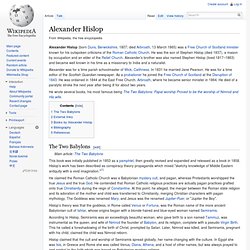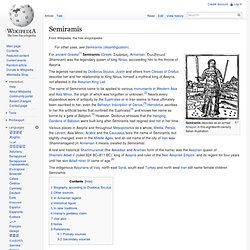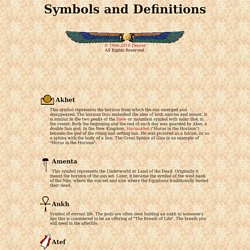

Sepharvaim. Sepharvaim - taken by a king of Assyria, probably Sargon II, (claimed in the Old Testament in 2 Kings 17:24; 18:34; 19:13; Isa. 37:13).

It was a double city, and received the common name Sepharvaim, i.e., "the two Sipparas," or "the two booktowns. " The Sippara on the east bank of the Euphrates is now called Abu-Habba; that on the other bank was Accad, the old capital of Sargon I, where he established a great library. The recent discovery of cuneiform inscriptions at Tel el-Amarna in Egypt, consisting of official despatches to Pharaoh Amenophis IV. and his predecessor from their agents in Palestine, leads some Egyptologists to conclude that in the century before the Exodus an active literary intercourse was carried on between these nations, and that the medium of the correspondence was the Babylonian language and script. (See Kirjath-Sepher.) Alexander Hislop. He wrote several books, his most famous being The Two Babylons: Papal worship Proved to be the worship of Nimrod and His wife.

The Two Babylons[edit] This book was initially published in 1853 as a pamphlet, then greatly revised and expanded and released as a book in 1858. Hislop's work has been described as conspiracy theory propaganda which mixed "sketchy knowledge of Middle Eastern antiquity with a vivid imagination. "[1] Then, according to Hislop, Constantine, though claiming to convert to Christianity, remained pagan but renamed the gods and goddesses with Christian names to merge the two faiths for his political advantage, under Satan's guidance. External links[edit] The Two Babylons by Alexander Hislop (online)Ralph Woodrow, The Babylon Connection? Books by Alexander Hislop[edit] (Sources of information include COPAC ) Bibliography[edit] References[edit]
Semiramis. Semiramis depicted as an armed Amazon in this eighteenth-century Italian illustration.

For ancient Greeks[1] Semiramis (Greek: Σεμίραμις, Armenian: Շամիրամ Shamiram) was the legendary queen of king Ninus, succeeding him to the throne of Assyria. The legends narrated by Diodorus Siculus, Justin and others from Ctesias of Cnidus describe her and her relationship to King Ninus, himself a mythical king of Assyria, not attested in the Assyrian King List. Various places in Assyria and throughout Mesopotamia as a whole, Media, Persia, the Levant, Asia Minor, Arabia and the Caucasus bore the name of Semiramis, but slightly changed, even in the Middle Ages, and an old name of the city of Van was Shamiramagerd (in Armenian it means created by Semiramis).
The indigenous Assyrians of Iraq, north east Syria, south east Turkey and north west Iran still name female children Semiramis. Biography according to Diodorus Siculus[edit] She then married Onnes or Menones, one of Ninus' generals. Egyptian Symbols and Definitions. Djed It is believed that the Djed is a rendering of a human backbone.

It represents stability and strength. It was originally associated with the creation god Ptah. Himself being called the "Noble Djed". As the Osiris cults took hold it became known as the backbone of Osiris . Djew Which means mountain, the symbol suggests two peaks with the Nile valley in the middle. Feather of Maat Represents truth, justice, morality and balance. Fetish of Osiris An animal skin hanging from a stick, this is a symbol of Osiris and Anubis. Flail and Crook A symbol of royalty, majesty and dominion. Heb The heb glyph represents an alabaster bowl. Heb-Sed The Heb-Sed glyph Is a combination of the heb glyph and the sed glyph. Hedjet The White Crown. Ieb This symbol represents a heart. Imenet These symbols represent the west or western desert AKA the land of the dead. Ka The ka is usually translated as "soul" or "spirit" The ka came into existence when an individual was born.
Khepresh Khet Maat.